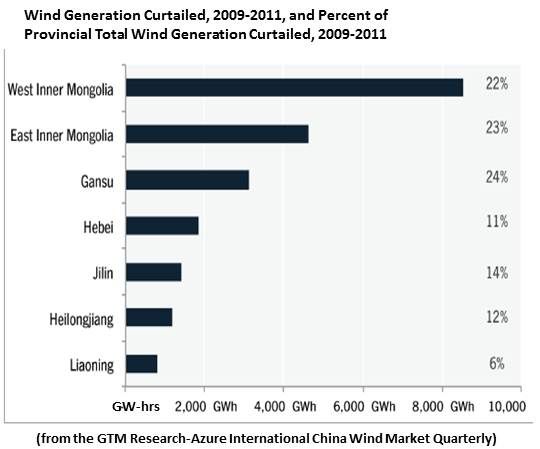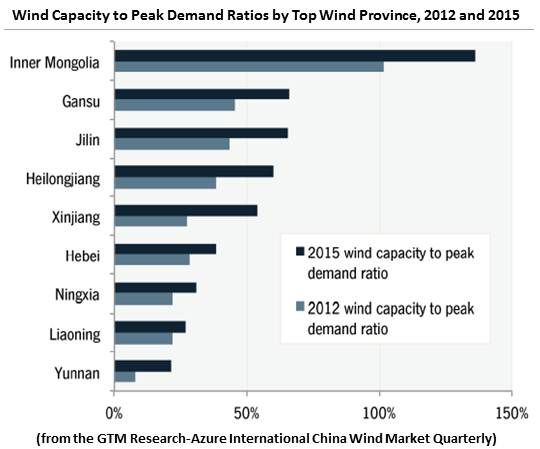China built 2.9 gigawatts of wind capacity in Q3 2012, according to the just-released GTM Research-Azure International China Wind Market Quarterly, and stands as the global leader in installed wind.
With 9 gigawatts expected to be completed in Q4, China wind should approach 18 gigawatts for the year, its highest annual installation number. That would put it at a cumulative 80 gigawatts of installed wind capacity.
But the numbers don’t tell the whole story.
“Curtailment remains one of the largest issues overhanging the future growth of wind power in China,” according to the publication. From 2009 to 2011, “China’s curtailed wind power resulted in a RMB 11.6 billion economic loss, which is equivalent to 6.77 million tons of coal, equivalent to 13.4 million tons CO2 emissions.”
Furthermore, “the ratio between wind capacity and peak demand would suggest” that curtailment “will worsen in areas already suffering” and will “expand to new areas. [... W]hile new transmission capacity will reach areas of high containment after 2014, it appears that it will fall considerably short of addressing the curtailment problem.”
Renewables, largely wind, represented about 26 percent of China's installed electric capacity in 2010, but only 18 percent of its generation and only 9 percent of final energy consumption, reported a recent study of curtailment in China by American Council on Renewable Energy Intern Liz Brody.
Part of the cause, Brody said, was the “lower-than-estimated capacity factors" of Chinese wind turbines.
But, she found, “the lack of grid connection, the throttling of wind energy, and turbine idling are the primary culprits.” This resulted, Brody’s study found, from policy failures that drove wind installation in remote provinces without drivers for new transmission and interconnection.

Source: GTM Research-Azure International China Wind Market Quarterly
Mid-to-late 1990s policies moved China’s 74 megawatts of wind in 1996 to 344 megawatts in 2000. “The Renewable Energy Law, which created a national framework for pricing, grid connection, and incentive policies came into effect in 2006,” Brody reported. “Its target was the installation of five gigawatts of wind-power capacity by 2010. By the end of 2008, 12.15 gigawatts worth had been constructed across 24 provinces – 143 percent above target and two years ahead of schedule.”
But “as late as 2009, a whopping 30 percent of installations had not been connected to the grid.”
Newer policies have somewhat rectified the situation, Brody told GTM. This is verified in the Q3 Quarterly, which puts current average curtailment at 16.9 percent.
One key challenge, Brody’s study said, is “the unique, semi-private status” of China’s state-owned enterprises (SOEs) which deeply influence Chinese enterprise but “often act in the interest of their bottom line rather than in response to development directives from the central government.”
Another, Brody’s study added, is that China’s central energy agencies have limited influence over state-owned grid operators State Grid and Southern Grid.
And despite the newest laws, Brody said, incentives remain misaligned.
“The new requirement to obtain centralized approval from the National Development and Reform Commission for all wind projects is certainly better than the previous law that required central approval only for projects above 50 megawatts and resulted in a lot of 49 megawatt projects that were reportedly carved from unapproved larger projects.”
Projects under 50 megawatts were “approved at the provincial level,” Brody said. “The way local officials are incentivized makes them more willing to approve things that would not necessarily perform long term.”

Source: GTM Research-Azure International China Wind Market Quarterly
More central approval “is good because it will put a cork in rampant new wind project development in areas already saturated,” Brody said, “but it can’t be the ultimate solution.”
Basic changes are needed, Brody said. “They have to stop giving the biggest contracts, discounted loans, free land and development priority to the SOEs because it disincentivizes smaller companies from innovating and slows technology advances.”
It might be necessary, she added, “to change the incentive structure so that developers are incentivized to build smaller scale wind projects closer to population centers or to integrate clean energy with buildings.”
An even bigger problem “is getting subsidies to the grid companies to help them pay for better interconnections,” Brody said. Because the grid companies are state owned and without competition, “the central government is going to have to shell out a lot of money to strengthen the grid.”
But the state is already building the biggest HVDC line in the world to connect the north and the south, Brody noted, and providing subsidies to the grid companies for interconnection. “The rhetoric has shifted from developing capacity to connection issues.”
Policies similar to U.S. renewables mandates now require regional grid companies to purchase a certain percentage of power in their localities, Brody said. “That seems like a good way to motivate grid companies to connect and turn on wind turbines,” she added, “but like anything in China, the questions are whether they can be enforced and whether there will be accurate reporting. It is a question anywhere in the world but maybe even more so in China.”
As new President Xi Jinping noted when he and Li Keqiang took office office during the just completed Eighteenth Congress, corruption has been endemic in China.
There is optimism that the new President, because he is next generation, has ties to the west, and is market oriented, may do more than pay lip service to fighting corruption. China’s soaring demand for energy and recent history of commitment to renewables, Brody added, fuels the optimism.

Source: GTM Research-Azure International China Wind Market Quarterly



